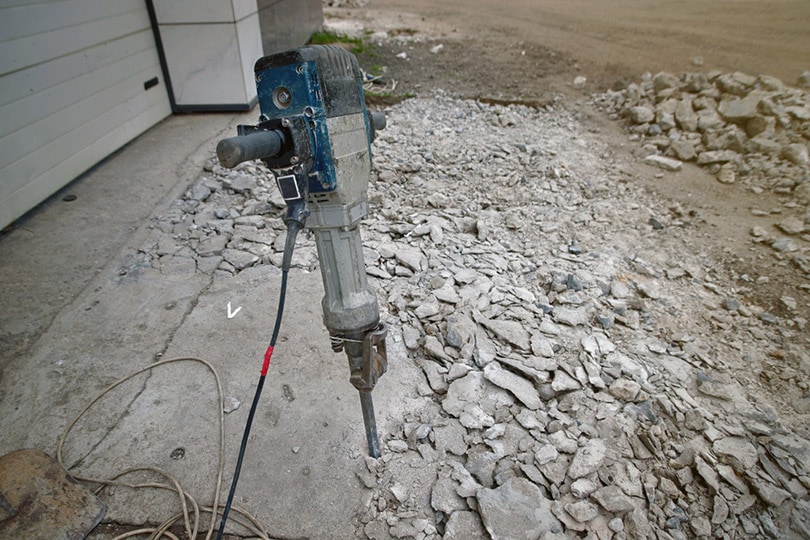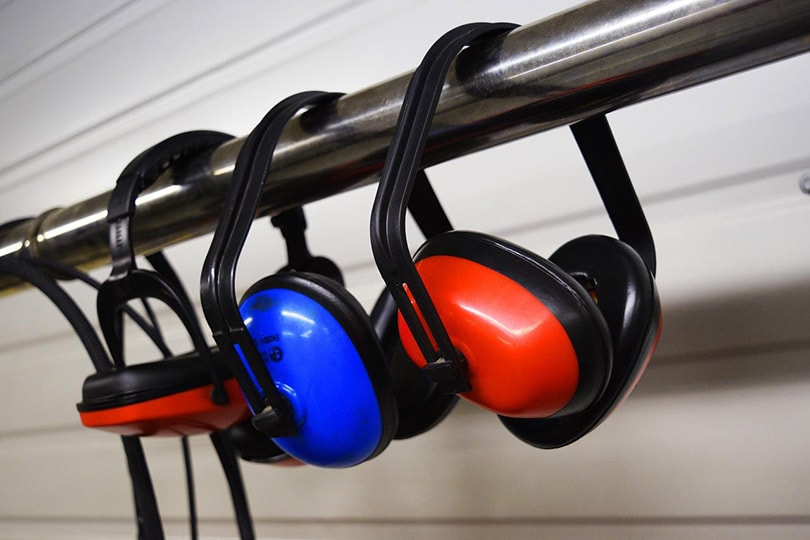How Loud Is a Jackhammer In Decibels (dB)? With Noise Comparison Chart
-
Visnja Radosavljevic
- Last updated:

We all know that jackhammers are loud, but did you ever wonder how loud is a jackhammer in decibels? If you have, here’s the answer to that question—a jackhammer is around 130dB. Jackhammers are extremely noisy, and when using one, you can experience noise-induced hearing loss if you’re not appropriately protected.
It might not sound like a big deal, but since the safe level of noise exposure is approximately 85 decibels, you quickly realize how harmful a jackhammer noise can be to your hearing.
Keep reading to learn more about the noise jackhammers make, how the noise compares to other louder/quieter noises, and how to protect yourself from loud noises.
Safe Noises Levels
The louder the sound, the more it can damage your hearing. Typically, sounds at 70 decibels or sounds below that are considered safe. Anything louder than 85 decibels can harm your hearing over time, especially if the exposure to the noise lasts for long periods. Everyone who listens to such noise for extended periods will likely suffer from hearing loss.
That’s why many workers, such as construction workers who use jackhammers, need to wear hearing protectors while working.
Many of us expose ourselves to harmful noises each day without even realizing it. Headphones that most people wear daily often have 94–110 decibels when set on the highest volume.
Still, most devices have volume controls where you can change the volume to a safer level.

How Many Decibels Are Harmful to Your Hearing?
Problems that loud noises cause can be severe, and you may never recover from them. That’s why it’s crucial to know how many decibels are harmful to your hearing. Sounds at 70 decibels and below are considered safe, but you’ll likely develop hearing issues if you listen to something at 70 decibels for a prolonged period.
We have created a chart to demonstrate how loud are things you encounter in your surroundings. The list starts from the quietest up to the highest noises in decibels. Louder noises that are over 120 decibels can lead to immediate hearing damage.
| Noise source | Decibels | Human response to these noises |
| Breathing | 10 | Generally don’t cause any hearing issues |
| Mosquito | 20 | Generally don’t cause any hearing issues |
| Whispering | 30 | Generally don’t cause any hearing issues |
| Rainfall | 40 | Generally don’t cause any hearing issues |
| Fridge | 50 | Generally don’t cause any hearing issues |
| Talking | 60 | Generally don’t cause any hearing issues |
| Traffic | 70 | The noise may begin to irritate you |
| Truck | 80 | The noise may begin to irritate you |
| Hairdryer | 90 | The noise may begin to irritate you |
| Helicopter | 100 | You can experience hearing loss after 15 minutes of exposure to noise this loud |
| Trombone | 110 | You can experience hearing loss after 2 minutes of exposure to noise this loud |
| Police siren | 120 | You can experience pain and a critical ear injury |
| Jackhammer | 130 | You can experience pain and a critical ear injury |
| Fireworks | 140 | You can experience pain and a critical ear injury |
Could Using a Jackhammer While Unprotected Damage Your Hearing?
As you can see, jackhammers are pretty high on the list. Since they have 130 decibels, you can experience immediate hearing damage or loss if you use a jackhammer without hearing protection.
They are one of the loudest tools that construction workers use. It’s not only the level of noise and decibels that will determine if you’ll suffer from hearing loss. Instead, other factors combined with the noise level will determine if a tool will damage your hearing or not:
- Time: The impact of noise also depends on the time of your exposure to it. When exposed to loud noises for continuous periods, the chances of hearing loss increase by the minute. If listening to noises at 85 decibels, they will harm you after a few hours. The ones at 100 decibels or louder will harm you after 15 minutes, while those over 110 decibels will damage your hearing in only 2 minutes.
- Distance: Also, the noise impact will depend on the distance from the noise. When working with tools such as a jackhammer, you’re holding it close to your body. That means you will suffer more consequences if you listen to the jackhammer unprotected. When you’re far away from the noise, the risk of hearing damage and loss becomes far
Why Are Jackhammers So Loud?
Jackhammers emit most of the noise due to the internal parts that are constantly moving. The piston inside a pneumatic jackhammer hits the striker plate over 1,800 times in a minute. The energy transmitted into the drill bit creates the noise, sounding like a loud bell.
How Loud Is the Jackhammer Compared to Other Tools?
| Tool | Noise in decibels | |
| Quietest | Loudest | |
| Orbital sander | 74 decibels | 97 decibels
|
| Screw driver | 90 decibels | 94 decibels
|
| Drill | 91 decibels | 99 decibels
|
| Grinder | 95 decibels | 109 decibels |
| Jig saw | 97 decibels | 102 decibels
|
| Hammer drill | 99 decibels | 116 decibels
|
| Impact wrench | 101 decibels | 111 decibels
|
| Circular saw | 103 decibels | 113 decibels
|
| Miter saw | 103 decibels | 113 decibels
|
| Jackhammer | around 130 decibels | |
As you can see, orbital sanders can be the quietest tool at only 74 decibels. Grinders and jigsaws are right in the middle with 109 decibels and 102 decibels, while jackhammers are the noisiest tool at the top of the list.
Ear Protection When Using a Jackhammer
It’s crucial to wear ear protection during use since the damage of using a jackhammer when unprotected could be severe. Wearing earplugs and muffs will reduce the noise level and help you keep your hearing safe. For each hearing protective gear piece, the manufacturer will provide the NRR (Noise Reduction Rating), so you can compare the products.
It’s best not to buy any noise-protective gear if the NNR is lower than 30. When working with such powerful, loud tools, you should combine earplugs and earmuffs for maximum protection. The NRR would be higher, and the tools wouldn’t impact your hearing.

How Do You Identify Noise Issues in the Workplace?
You should always check if the noise in your workplace is a potential problem for your hearing. Here are some of the indicators of possibly dangerous noise issues:
- Noise that is louder than city traffic
- Needing to raise voices when talking at 3 feet away
- You hear a humming noise when you leave work
- You cannot communicate in a crowded, noisy area
How Can You Determine the Noise Levels Around You?
The simplest way to quickly determine the noise level and know which protective gear you should buy is to use a noise dosimeter. It will provide you with information about the noise exposure and give you signals if your hearing could suffer from damage.
Nowadays, there are mobile apps you can use to measure the noise level if you don’t have a dosimeter. Another helpful way would be to know the approximate noise level of the tool you are using to determine the NRR your hearing protective gear should have.
What Is the Loudest Sound Ever Measured?
Over the years, people have measured a lot of extremely loud noises, some even having the capability to pierce your eardrums or pop your lungs.
- Lesser Bulldog Bats (137 decibels): These mammals can produce noise of 137 decibels loud, although we can’t hear it. Their pitch is not within our perception limits, so we cannot perceive the sound.
- Howler Monkeys (140 decibels): These monkeys are among the largest monkey species in the world. You can hear them from 3 miles away when they amplify their voice.
- Gunfire (140–190 decibels): Noises this loud can immediately damage peoples’ hearing. Most guns have at least 140 decibels when fired, while some reach 190 decibels, leading to hearing loss if shooting unprotected.
- Saturn V Rocket (204 decibels): This rocket was launched 13 times, producing noise of 204 decibels, which luckily, NASA dampens.
- Krakatoa (189–202 decibels when 3 miles away/ 172 decibels when 100 miles away): Krakatoa erupted back in 1893, and it was so strong that it made tsunamis, destroyed half the island, and killed multiple people. The blast was so powerful that the noise nearby was 189–202 decibels, while it was 107 decibels even 100 miles away.
Final thoughts
As you can see, jackhammers are very loud. Their noise can cause severe hearing damage and hearing loss, so always be well prepared and protected. Never use any tools without hearing protection to ensure your hearing will be protected and won’t get damaged in the long run.
Featured Image Credit: Tricky_Shark, Shutterstock
Contents


